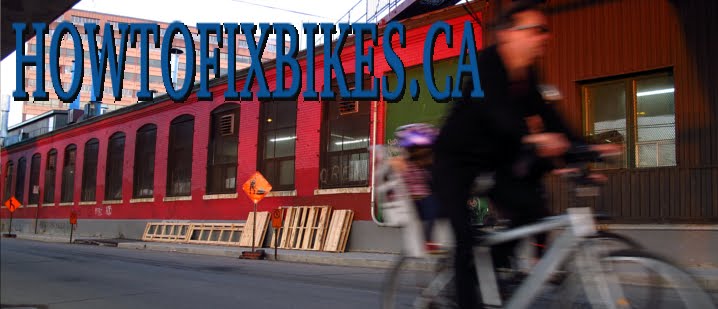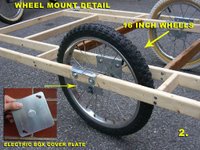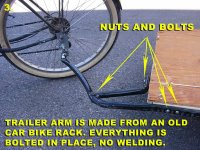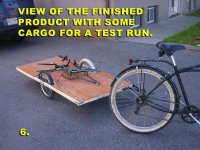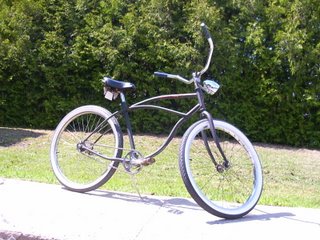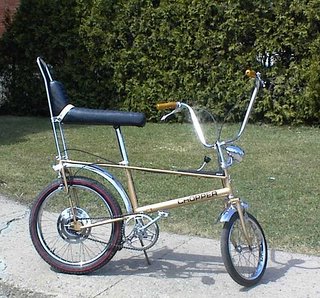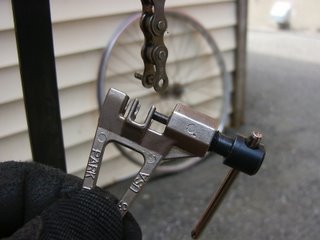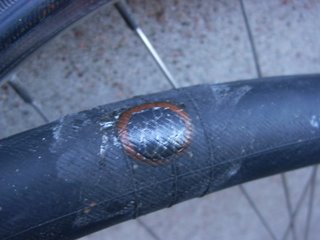
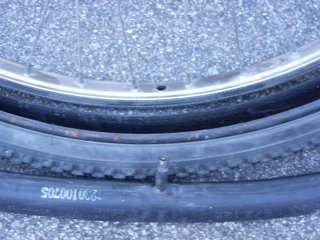
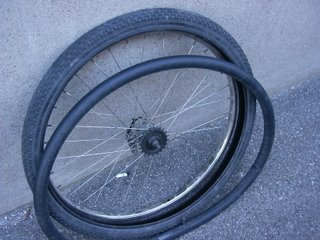
Ever go to a bike shop to get a flat fixed and you end up with the same problem a couple of days later? Then you have been the victim of poor workmanship or a mechanic with low work ethics. Not all bike shops are bad, most of them are pretty good, but if you want to fix a flat yourself, it is pretty easy to do. Here's how-to:
First off, remove any remaining air in the tube if there is still some left. Take the tire off the wheel. This can be done by hand, but sometimes the use of tire spoons is necessary. Removing the tire one sidewall at a time is also easier.
Now, put the wheel up against a wall, put the tire against the wheel at the same place it was on the rim and finally put the tube against the tire at the same place it was in the tire. You can use the valve on the tube and the valve hole on the rim to help you.
You may ask:"but why do all this", because installing a new tube will not tell you WHY you had a flat and you might end up with another puncture. While it is up against the tire, fill the bad tube with air until you hear the air coming out of the hole. Find the hole and look where it is compared to the tire and wheel.
Ok, now it's time for the diagnostic, you'll find a hole somewhere and different types of holes means different things:
One puncture on the outside radius of the tube means that you rolled on something sharp. To make sure that it's not there anymore, feel the inside of the tire for anything sharp and remove it. Careful now, if it punctured your tube, it will puncture your skin. Also, it is possible that your tire is worn out and needs to be replaced, bald tires are not too strong against a sharp little rock.
One puncture on the inside of the tube radius means that the rubber tape on the inside of the rim is missing or displaced and a spoke punctured it. See where this happened in relation with the wheel and fix the problem. If the tape is broken, you can use good old duct tape to fix it.
One puncture on the side of the tube. Check your tire sidewall, you may have a busted tire that exposes your tube. Time to change it.
Two punctures side by side in the inside radius of the tube means that you have pinched it while riding. This happens when the tire is not inflated enough and you hit a major bump or hole. This pinchs the tube against the rim and PAF! Read the maximum pressure allowed on the tire and inflate within 5 to 10 psi of the posted limit.(I had this happen to me while bombing down a rocky trail, not fun.)
Star shaped puncture anywhere on the tube. That's over inflation and your tube has blown up. If you were fortunate enough to be there when it happens, it makes a pretty cool loud BANG! If you were unfortunate enough to be there when it happened and you were actually riding, chances are you are reading this from a hospital bed and it wasn't cool. Always inflate within 5 to 10 psi of the posted limit on the tire. You need to leave room for climate changes and heat from the rim when applying the brakes. This is important when riding in hot weather.
So now you have figured out what caused the flat and your ready to patch it up and go.....NOT! Buy a new tube and install it. A patched up tube is trouble waiting to happen at the least desired moment. Patch up your old tube and check that it is well patched but keep it as a spare on your bike. It will bring you home if you get stuck.
Put the new tube in the tire after inflating it just barely so it has shape. This will make it easier to put in the tire. If you have put too much and this prevents an easy re-entry, simply remove the excess air. Put the tire back on. Depending on many factors, this could be easy or simple. If you cannot do it by hand, you will need tire spoons to work the tire back on the rim. Just be careful not to pinch the tube while using those.
Once your tire is back on the rim, put the wheel on its side, on the ground and put in about 10 psi in it. Stop to check if the tire is properly seated all around the rim on both sides. I failed to do this once and as I was about to release the air after noticing a huge tube balloon on a 26 inch wheel....BOOM! My wife came running into the garage thinking I was shot with a 12 gauge! My ears rang for an hour! Ok, enough with my war stories, now that the tire is evenly set all around the rim, on both sides, pump it to the proper pressure and reinstall the wheel. Make sure that the wheel is seated properly in the frame or fork that all the bolts are tightened before leaving on your next ride.
Tip of the day: If you ever notice a slash in the sidewall of the tire before it blows and you still have a good distance to go, use a folded dollar bill and shove it between the tube and the inside of the tire. Reinflate and you should be good to go.
Good luck and ride safe.

